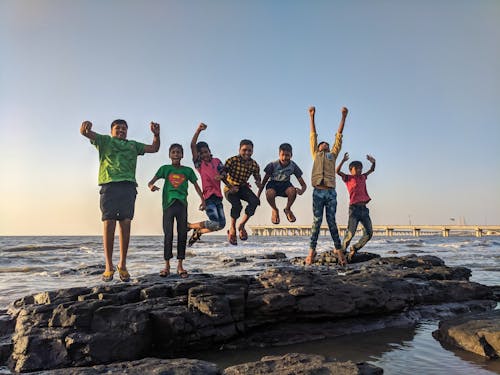Health Care Tips for Youngsters
Physical Instruction
Youngsters who are physically fit assimilate and hold newdata more viably than kids who are flabby, another examination discovers,bringing up auspicious issues about the intelligence of cutting physical instruction programs at schools.
An agent examine, exhibited in fourth-and fifth-grade understudies who went around and generally practiced vivaciously for something like 10 minutes before a math test scored higher than youngsters who had sat unobtrusively before the test.
In a huge scale investigation of many schoolchildren distributed
in of Pediatrics, scientists incorporated every tyke's physical wellness, as
estimated by a coordinated run, weight record and scholarly accomplishment in
English and math, in view of the state's government sanctioned test scores.
Better wellness ended up being connected to fundamentally higher accomplishment
scores, while, curiously, body measure had no job. Understudies who were
overweight however generally fit had higher test scores than lighter, less-fit
kids.
Investigation
Investigation
To date, in any case, no investigation explicitly had inspected whether and in what ways physical wellness may influence how youngsters learn. So analysts at the University of Illinois at Urbana-Champaign
as of late ventured into that break, selecting a gathering of neighborhood
9-and 10-year-old young men and young ladies, testing their oxygen consuming
wellness on a treadmill, and after that soliciting 24 from the most fit and 24
of minimal fit to come into the activity physiology lab and work on some
troublesome remembrance assignments.
Learning is, obviously, a perplexing procedure, including
not just the taking in and putting away of new data as recollections, a
procedure known as encoding, yet in addition reviewing that data later. Data
that can't be reviewed has not by any stretch of the imagination been found
out.
Prior investigations of kids' learning styles have appeared
most adapt all the more promptly on the off chance that they are tried on
material while they are learning it. Essentially, in the event that they are
tested while retaining, they recall all the more effectively. Straight
remembrance, without irregular support amid the procedure, is harder, despite
the fact that it is additionally how most kids think about.
Social media usage
Social media usage

For this situation, the specialists picked to utilize thetwo ways to deal with learning, by giving their young volunteers iPads onto whicha few maps of fanciful terrains had been stacked. The maps were outlined into
districts, each with a four-letter name. Amid one learning session, the kids
were demonstrated these names set up for six seconds. The names at that point
showed up on the guide in their right position six extra occasions while
youngsters gazed at and endeavored to remember them.
In a different learning session, district names showed up on
an alternate guide in their appropriate area, at that point moved to the edges
of the guide. The kids were approached to tap on a name and match it with the
right district, giving in-session testing as they remembered.
Specialists picked to utilize the two ways to deal with learning, by giving their young volunteers iPads onto which a few maps of fanciful terrains had been stacked
Multi day later, the majority of the kids came back to the
lab and were asked to accurately name the different maps' areas. The outcomes
demonstrate that, over every one of, the youngsters performed comparatively
when they were approached to review names for the guide when their retention
was fortified by testing.
Be that as it may, when the review included the more
troublesome kind of learning — retaining without irregular testing — the
youngsters who were in better vigorous condition fundamentally beat the
less-fit gathering, recalling around 40 percent of the districts' names precisely,
contrasted and scarcely 25 percent exactness for the flabby children.
This finding recommends that "larger amounts of
wellness have their most noteworthy effect in the most testing
circumstances" that youngsters face mentally, the investigation's writers
compose. The more troublesome something is to learn, more physical wellness
may help youngsters in learning it.
 Long term
exercise
Long term
exercise
Obviously, this examination did not concentrate explicitly
on the sort of dynamic exercise run of the mill of break, however on longer-term,
in general physical wellness in youthful youngsters. Be that as it may, in
doing as such, it unpretentiously strengthens the significance of break and
comparative physical action programs in schools, its creators accept.
In the event that kids are to create and keep up the sort ofoxygen consuming wellness that intensifies their capacity to learn, they oughtto take part in "something like an hour daily" of incredible physicalaction. Schools, where kids spend such huge numbers of their waking hours, give
the most coherent and strategically conceivable spot for them to get such
exercise, he said.
Or then again as he and his co-creators dryly note in the
examination: "Diminishing or disposing of physical instruction in schools,
as is regularly done in tight money related occasions, may not be the most
ideal approach to guarantee instructive accomplishment among our youngsters
Out of the blue, researchers contrasted head-with head the
neurological effects of various sorts of activity: running, weight preparing
and high-force interim preparing. The astonishing outcomes propose that going
hard may not be the best alternative for long haul mind wellbeing.
As I have frequently composed, practice changes the
structure and capacity of the mind. Concentrates in creatures and individuals
have appeared physical action by and large builds cerebrum volume and can
diminish the number and size of age-related gaps in the mind's white and dim
issue.
Exercise likewise, and maybe most resoundingly, increases
grown-up neurogenesis, which is the production of new cerebrum cells in an
officially develop mind. In concentrates with creatures, work out, through
running wheels or treadmills, has been found to twofold or even triple the
quantity of new neurons that show up a while later in the creatures'
hippocampus, a key territory of the mind for learning and memory, contrasted
with the cerebrums of creatures that stay inactive. Researchers trust that
activity impactsly affects the human hippocampus.
A few types of activity
A few types of activity might be significantly moresuccessful than others at building up the cerebrum, as indicated by anoteworthy new examination in rodents. Out of the blue, researchers contrasted
head-with head the neurological effects of various kinds of activity: running,
weight preparing and high-force interim preparing. The astounding outcomes
recommend that going hard may not be the best choice for long haul cerebrum
wellbeing.
As I have regularly composed, practice changes the structure
and capacity of the cerebrum. Concentrates in creatures and individuals have
appeared physical movement by and large builds mind volume and can diminish the
number and size of age-related openings in the cerebrum's white and dim issue.
Exercise likewise, and maybe most resoundingly, expands
grown-up neurogenesis, which is the production of new mind cells in an
officially develop cerebrum. In concentrates with creatures, work out, through
running wheels or treadmills, has been found to twofold or even triple the
quantity of new neurons that show up a short time later in the creatures'
hippocampus, a key region of the mind for learning and memory, contrasted with
the cerebrums of creatures that stay inactive. Researchers trust that activity
impactsly affects the human hippocampus.
These past investigations
 |
| Boy Running during Sunset |
These past investigations of activity and neurogenesis
naturally have concentrated on separation running. Lab rodents realize how to
run. Be that as it may, regardless of whether different types of activity in
like manner brief increments in neurogenesis has been obscure and is an issue
of expanding interest, given the developing prominence of exercises, for
example, weight preparing and high-power interims.
So for the new examination, which was distributed for the
current month in the Journal of Physiology, scientists of some University and
different foundations accumulated a substantial gathering of grown-up male
rodents. The analysts infused the rodents with a substance that marks new
cerebrum cells and after that set gatherings of them to a variety of various
exercises, with one gathering staying inactive to fill in as controls.
A portion of the creatures were given running wheels in
their pens, enabling them to keep running freely. Most ran modestly
consistently for a few miles, albeit singular mileage fluctuated.
Others started obstruction preparing, which for rodents
includes climbing a divider with little loads joined to their tails.
Still others took up what might be compared to high-force
interim preparing. For this routine, the creatures were set on little
treadmills and required to run at a fast and strenuous pace for three minutes,
trailed by two minutes of moderate skittering, with the whole arrangement
rehashed twice more, for an aggregate of 15 minutes of running.
These schedules proceeded for seven weeks, after which the
scientists minutely analyzed mind tissue from the hippocampus of every creature.
They found altogether different dimensions of neurogenesis,
contingent upon how every creature had worked out.
Those rodents that had run on wheels indicated powerful
dimensions of neurogenesis. Their hippocampal tissue overflowed with new neurons,
definitely more than in the cerebrums of the stationary creatures. The more
noteworthy the separation that a sprinter had secured amid the examination, the
more new cells its mind presently contained.
Expansion of Neurogenesis

There were far less new neurons in the minds of the
creatures that had finished high-power interim preparing. They indicated fairly
higher sums than in the stationary creatures yet far not exactly out yonder
sprinters.
Also, the weight-preparing rodents, despite the fact that
they were a lot more grounded toward the finish of the investigation than they
had been toward the begin, demonstrated no perceivable expansion of
neurogenesis. Their hippocampal tissue looked simply like that of the creatures
that had not practiced by any means.
Clearly, rodents are not individuals. Be that as it may, the
ramifications of these findings are provocative. The sustained aerobic exercise
might be most beneficial for brain health also in humans.
Writen By - M. Sathik Ali, Choose Healthy Food
Writen By - M. Sathik Ali, Choose Healthy Food


0 comments:
Post a Comment